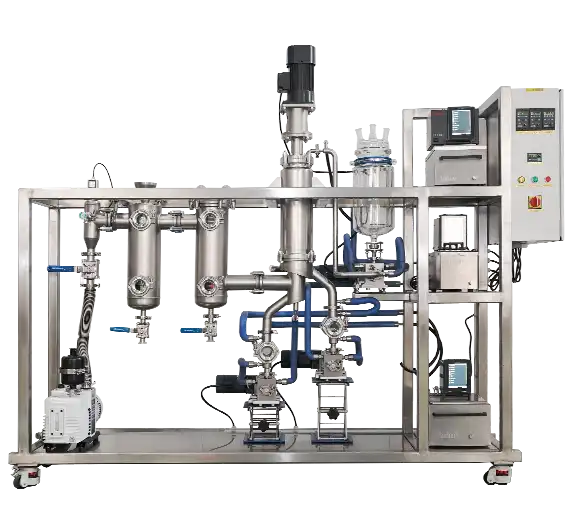How Stainless Steel Wiped Film Molecular Distillation Can Improve Your Product Quality?
Are you struggling with product impurities, thermal degradation, or low recovery rates in your purification processes? Stainless Steel Molecular Distillation offers a revolutionary solution by operating under ultra-high vacuum conditions (0.1Pa) and low temperatures, preserving heat-sensitive compounds while achieving separation efficiency up to 98% purity. This advanced technology addresses critical challenges in pharmaceutical, food, and chemical industries where traditional distillation methods fail to deliver the required product quality standards.

Understanding Stainless Steel Molecular Distillation Technology
Stainless Steel Molecular Distillation represents a paradigm shift in separation technology, fundamentally different from conventional distillation methods. Unlike traditional processes that rely on boiling point differences, this advanced system exploits the variance in molecular mean free paths between different substances. The technology operates in an ultra-high vacuum environment, typically achieving pressures as low as 0.1Pa, which allows molecules to travel from the heated evaporating surface to the condensing surface without experiencing collisions with other molecules. This collision-free environment is crucial for maintaining molecular integrity, especially for thermally sensitive materials that would otherwise degrade at elevated temperatures required by conventional distillation. The stainless steel construction, specifically using 316-grade material, provides exceptional corrosion resistance and maintains product purity throughout the separation process. This material choice is particularly important when processing aggressive chemical compounds or pharmaceutical ingredients where even trace contamination can compromise product quality. The wiped film mechanism ensures continuous thin-layer formation on the evaporating surface, maximizing heat transfer efficiency while minimizing residence time. This combination of factors makes Stainless Steel Molecular Distillation ideal for purifying high-value compounds such as omega-3 fatty acids, squalene, essential oils, and pharmaceutical intermediates.
Key Components That Drive Performance Excellence
The performance of Stainless Steel Molecular Distillation systems depends heavily on precision-engineered components working in harmony. KingLai vacuum ball valves maintain system integrity by ensuring stable vacuum conditions throughout operation, preventing pressure fluctuations that could compromise separation efficiency. SEW brand motors, bearing UL certification, provide reliable rotational power for the wiper system, operating continuously without performance degradation. ABB frequency converters deliver precise speed control, allowing operators to optimize wiper rotation between 100-400 rpm depending on material viscosity and feed rate requirements. The wiper or roller materials, constructed from imported PTFE or graphite, offer superior chemical resistance while maintaining low friction coefficients. These materials ensure consistent film formation across the evaporating surface without causing mechanical wear or introducing contaminants. SKF ceramic bearings eliminate the need for lubrication, removing a potential contamination source while providing exceptional wear resistance in high-temperature, high-vacuum environments. Magnetic sealing technology replaces traditional mechanical seals, significantly improving vacuum integrity while reducing maintenance requirements and preventing product leakage.
Multi-Stage Configuration for Maximum Separation Efficiency
Single-stage Stainless Steel Molecular Distillation systems provide excellent results for straightforward separation tasks, but multi-stage configurations unlock unprecedented purification capabilities. Dual-stage systems allow sequential separation where the first stage removes light components and impurities, while the second stage achieves final product refinement. This approach is particularly effective for fish oil purification, where achieving 80% EPA and DHA concentration requires progressive removal of different fatty acid fractions. Three-stage configurations enable even more sophisticated separations, as demonstrated in waste lubricating oil regeneration where different viscosity-grade base oils are sequentially recovered. The thermal efficiency of multi-stage systems improves dramatically because the residual heat from each stage preheats the feedstock for subsequent stages, reducing overall energy consumption. Well One's modular design philosophy allows customers to start with single-stage systems and expand to multi-stage configurations as production requirements grow. Each stage operates independently with dedicated vacuum systems, temperature controls, and collection vessels, providing maximum operational flexibility. The ABB control system integrates all stages, enabling automated operation with real-time monitoring of critical parameters including temperature, pressure, feed rate, and product flow.
Superior Product Quality Through Advanced Separation
Product quality improvement with Stainless Steel Molecular Distillation manifests across multiple dimensions that directly impact commercial value and market competitiveness. The ultra-high vacuum operation eliminates oxidative degradation, a critical concern when processing unsaturated compounds like omega-3 fatty acids or essential oils. Traditional vacuum distillation operating at 1-10 mbar cannot prevent oxidation reactions that compromise product stability and reduce shelf life. Operating at 0.1Pa, molecular distillation creates an environment where oxidative reactions become thermodynamically unfavorable, preserving the original molecular structure and biological activity of sensitive compounds. Temperature control represents another crucial quality factor where molecular distillation excels dramatically compared to conventional methods. Heat-sensitive materials like rose essential oil, squalene, and pharmaceutical intermediates suffer irreversible damage when exposed to temperatures exceeding their degradation thresholds. Stainless Steel Molecular Distillation operates at temperatures 50-100°C lower than conventional distillation for equivalent separation tasks, protecting molecular integrity while achieving superior purity levels. This temperature advantage becomes particularly significant for complex molecules with multiple functional groups that undergo rearrangement, polymerization, or decomposition at elevated temperatures.
Achieving Pharmaceutical-Grade Purity Standards
Pharmaceutical applications demand exceptional purity levels that traditional separation methods struggle to achieve consistently. Stainless Steel Molecular Distillation technology addresses this challenge through its unique separation mechanism that discriminates based on molecular weight differences as small as 50 daltons. For polyethylene glycol synthesis, achieving narrow molecular weight distribution is essential for pharmaceutical excipient applications. Traditional batch reactors produce PEG with dispersity indices above 1.05, creating a heterogeneous product mixture. Molecular distillation refines this crude product, achieving dispersity indices below 1.02 and removing oligomeric impurities that could trigger adverse reactions in sensitive patient populations. Squalene purification demonstrates another pharmaceutical application where product quality directly correlates with market value and therapeutic efficacy. Crude squalene extracted from plant sources contains fatty acids, esters, waxes, and other lipophilic contaminants that reduce biological activity and cause allergic reactions. Multi-stage Stainless Steel Molecular Distillation progressively removes these impurities, achieving 98% purity while recovering valuable co-products like fatty acid esters. The 316 stainless steel construction ensures zero metallic contamination, meeting stringent pharmaceutical manufacturing standards including FDA 21 CFR Part 11 compliance for equipment materials in contact with drug substances.
Food Industry Applications and Quality Enhancement
Food-grade product purification presents unique challenges balancing purity requirements with sensory attributes and nutritional value preservation. Fish oil refinement exemplifies these competing demands where EPA and DHA concentration must increase from 30% to 80% while eliminating fishy odors, reducing peroxide values, and maintaining light product color. Traditional alkali refining achieves only 16% recovery rates while damaging beneficial compounds through saponification reactions. Stainless Steel Molecular Distillation achieves 70% recovery rates, producing odorless, light-colored fish oil with peroxide values below 5 meq/kg, meeting international standards for pharmaceutical-grade omega-3 supplements. Tea oil deacidification represents another food application where product quality improvement directly translates to premium market positioning. Camellia oleifera seed oil promoted by the United Nations Food and Agriculture Organization as a superior edible oil suffers from high free fatty acid content that causes rancidity and reduces nutritional value. Conventional alkali refining removes free fatty acids but generates significant waste and destroys beneficial phytochemicals including squalene, tocopherols, and polyphenols. Molecular distillation selectively removes free fatty acids while preserving these valuable compounds, producing premium-grade tea oil commanding 3-5 times higher market prices compared to conventionally refined products.
Technical Specifications That Define Performance
The technical specifications of Stainless Steel Molecular Distillation systems directly determine their capability to meet specific production requirements and quality standards. Operating pressure represents the most critical parameter, with Well One systems achieving 0.1Pa vacuum levels through advanced pump configurations and leak-tight construction. This ultra-high vacuum enables molecular mean free path values exceeding 10 centimeters, ensuring collision-free molecular transport from evaporating to condensing surfaces. Comparative systems operating at 1-5 mbar cannot achieve true molecular distillation conditions, resulting in lower separation efficiency and increased thermal exposure. Material selection extends beyond the primary 316 stainless steel construction to encompass every component contacting the process stream. Seals, gaskets, and O-rings utilize perfluoroelastomer materials maintaining integrity across temperature ranges from -40°C to +250°C while resisting attack by organic solvents, acids, and bases. The evaporating surface receives specialized finishing achieving Ra values below 0.4 micrometers, promoting uniform thin-film formation and preventing product holdup that could cause thermal degradation. Cold trap systems employing both coil and liquid nitrogen configurations capture volatile impurities before they reach the vacuum pump, protecting pump oil from contamination while recovering valuable solvent components.
Workflow Optimization for Consistent Results
Operational consistency determines whether laboratory-scale success translates to industrial production reliability. Well One's standardized workflow protocols eliminate operator variability while ensuring equipment longevity and product consistency. The startup sequence begins with cold trap pre-cooling using liquid nitrogen, achieving temperatures below -80°C before vacuum pump activation. This sequence prevents volatile compounds from reaching the pump during initial evacuation when system pressure transitions from atmospheric to operational vacuum levels. Achieving target pressure below 0.5 mbar typically requires 20-30 minutes depending on system volume and leak rate. Feed rate optimization represents a critical variable balancing throughput against separation efficiency and product quality. Excessive feed rates create thick films that reduce heat transfer efficiency and increase residence time, potentially causing thermal degradation. Insufficient feed rates waste production capacity and increase energy consumption per kilogram of product. Well One systems employ precision metering pumps with flow rate control accurate to ±2%, enabling operators to identify optimal conditions during commissioning trials. The wiper speed adjusts automatically based on material viscosity, maintaining consistent film thickness across varying feed compositions. ABB control systems record all process parameters, facilitating troubleshooting and process optimization through data analysis.
Customization Capabilities for Diverse Applications
Industrial applications present unique challenges requiring customized solutions beyond standard equipment configurations. Well One's OEM and ODM capabilities enable tailored designs addressing specific customer requirements while maintaining quality and reliability standards. One pharmaceutical client required UL-listed electrical components for US market compliance combined with Huber brand chiller integration for precise temperature control. The engineering team developed a compact configuration reducing footprint by 40% while maintaining full functionality, enabling installation in existing facility space without building modifications. Another customization example involved glass feeding tanks for visual process monitoring combined with dual external condensers for high-capacity operation. This configuration suited vitamin distillation applications where product color monitoring provides real-time quality feedback. The square tube bracket design provided exceptional stability while facilitating maintenance access to condensers and collection vessels. For extractive industries, a specialized design incorporated front-end stirring tanks dissolving solid samples before entering the wiped film distillation system, eliminating batch processing bottlenecks and enabling continuous operation. These customized solutions demonstrate Well One's engineering capability to address unique application challenges while maintaining the performance advantages inherent to Stainless Steel Molecular Distillation technology.
Industrial Applications Across Multiple Sectors
The versatility of Stainless Steel Molecular Distillation technology manifests through successful implementations across pharmaceutical, food, petrochemical, and specialty chemical industries. Each sector presents distinct challenges and quality requirements that molecular distillation addresses through its unique operating principles. In pharmaceutical manufacturing, the technology enables production of high-purity intermediates and active pharmaceutical ingredients that conventional methods cannot achieve without extensive chemical processing. The elimination of reactive solvents and harsh reagents simplifies regulatory compliance while reducing environmental impact and manufacturing costs. New materials production increasingly relies on molecular distillation for epoxy resin purification where low total chlorine content is essential for electrical insulation applications. First-stage distillation removes low-boiling impurities while preheating feedstock for second-stage separation that removes hetero groups and oligomeric species, producing epoxy resins with total chlorine content below 100 ppm. Petrochemical applications include waste lubricating oil regeneration where molecular distillation recovers multiple base oil grades through sequential multi-stage processing. This closed-loop approach reduces waste disposal costs while generating revenue from previously discarded materials, demonstrating the economic and environmental benefits of advanced separation technology.
Essence and Fragrance Industry Breakthroughs
Natural essential oil purification represents one of the most demanding applications for separation technology, combining extreme thermal sensitivity with stringent purity requirements and high product value. Rose essential oil, commanding prices exceeding $10,000 per kilogram, requires purification methods that preserve delicate aromatic compounds while removing waxes, chlorophyll, and other contaminants that compromise fragrance quality. Supercritical CO2 extraction produces crude rose oil containing these undesirable components, while traditional dewaxing with chilled solvents causes molecular rearrangement and oxidation, destroying the characteristic fragrance profile. Stainless Steel Molecular Distillation technology revolutionizes rose oil purification by operating at temperatures below 80°C under ultra-high vacuum, preventing thermal damage while achieving wax removal efficiency exceeding 95%. The resulting essential oil exhibits exceptional fragrance intensity and complexity, free from waxy residues that cause cloudiness and precipitation. Plant oil purification for cosmetic applications demonstrates similar advantages, with final products containing less than 10 ppm residual solvents compared to 100-500 ppm achievable with conventional vacuum evaporation. This dramatic reduction in solvent residues eliminates potential skin irritation and allergic reactions, supporting premium market positioning and regulatory compliance in multiple international markets.
Fine Chemicals and Specialty Products
Glycerin monostearate production illustrates molecular distillation's capability to handle complex separation tasks involving multiple component removal in a single processing sequence. The crude product from glycerin and hydrogenated oil esterification contains monostearate (desired product), along with unreacted glycerin, free fatty acids, diglycerides, and triglycerides. Single-stage distillation cannot achieve sufficient separation selectivity between these chemically similar compounds. Well One's two-stage molecular distillation configuration first removes glycerin and free fatty acids, then separates monostearate from di- and triglycerides, achieving final product purity exceeding 95% with monostearate content above 90%. Lanolin derivatives production for cosmetic applications presents another fine chemical challenge where molecular distillation enables product diversification and value addition. Crude lanolin contains multiple molecular weight fractions requiring separation to produce specialized derivatives including polyoxyethylene lanolin, acetyllanolin, and lanolin acid esters. Sequential molecular distillation separates these fractions based on molecular weight differences, providing feedstocks for chemical modification. Physical and chemical derivatization of separated fractions produces specialized emollients commanding premium prices in luxury cosmetic formulations, demonstrating how advanced separation technology unlocks market opportunities inaccessible with conventional processing methods.
Conclusion
Stainless Steel Molecular Distillation fundamentally transforms product quality across pharmaceutical, food, petrochemical, and specialty chemical industries through ultra-high vacuum operation, precise temperature control, and advanced engineering design. Achieving 98% purity levels, 70% recovery rates, and thermal degradation elimination addresses critical quality challenges that conventional separation methods cannot overcome, delivering measurable commercial advantages through premium product positioning and expanded market opportunities.
Cooperate with Xi'an Well One Chemical Technology Co., Ltd
Since 2006, Xi'an Well One Chemical Technology Co., Ltd., backed by Xi'an NewSet Chemical Equipment Technology Co., Ltd., has specialized in synthesis and purification separation equipment. With a 1,500 m² office, 500 m² R&D laboratory, and 4,500 m² manufacturing facility, the company delivers comprehensive services including process development, equipment design, testing, and pilot-scale trials. Our expert team provides molecular distillation devices from laboratory to industrial scale, ensuring production capacity and product quality through 19 years of accumulated expertise.
As a leading China Stainless Steel Molecular Distillation factory, China Stainless Steel Molecular Distillation supplier, and China Stainless Steel Molecular Distillation manufacturer, we offer competitive China Stainless Steel Molecular Distillation wholesale pricing. Our Stainless Steel Molecular Distillation for sale includes single-stage, dual-stage, and three-stage configurations with CE, ISO, UL, and SGS certifications. Every High Quality Stainless Steel Molecular Distillation system features 316 stainless steel construction, ABB control systems, and achieves 0.1Pa vacuum degree. With competitive Stainless Steel Molecular Distillation price and comprehensive OEM & ODM support backed by our own factory covering over 5,000㎡, we deliver premium quality through selected materials, custom designs with 3D animation, and complete R&D, production, sales, and support services with 1-year warranty.
Contact our technical team at info@welloneupe.com to discuss your specific purification challenges and discover how our Stainless Steel Molecular Distillation solutions can elevate your product quality while optimizing production efficiency. Bookmark this page for future reference when exploring advanced separation technologies for your manufacturing operations.
References
1. Batistella, C.B., Moraes, E.B., Filho, R.M., Maciel, M.R.W. "Molecular Distillation: Rigorous Modeling and Simulation for Design and Operation of Industrial Units" in Applied Thermal Engineering, Industrial Separation Processes Research Group, State University of Campinas, 2005.
2. Cvengros, J., Lutisan, J. "Mean Free Path of Molecules on Molecular Distillation" in Chemical Engineering Journal, Department of Chemical and Biochemical Engineering, Slovak University of Technology, 1995.
3. Martini, S., Añón, M.C. "Commercial Purification of Squalene from Vegetable Sources" in Journal of the American Oil Chemists' Society, Centro de Investigación y Desarrollo en Criotecnología de Alimentos, Universidad Nacional de La Plata, 2007.
4. Haas, M.J. "Improving the Economics of Biodiesel Production Through the Use of Low Value Lipids as Feedstocks: Vegetable Oil Soapstock" in Fuel Processing Technology, United States Department of Agriculture, Eastern Regional Research Center, 2005.



